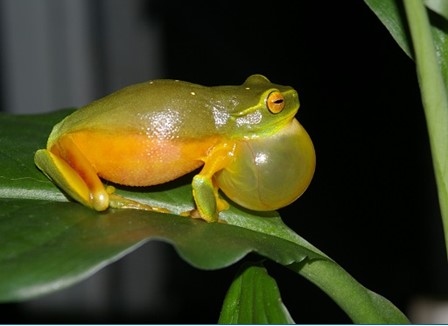
Attracting frogs into your backyard is not difficult. If you create the right conditions and habitat the frogs will find their way. You may even have resident frogs already. The presence of frogs is a good indicator of the overall health of an ecosystem. By creating suitable habitats and refuges for frogs in our own backyards we can help their survival in challenging urban environments.
Some simple ways to encourage frogs to visit or move in include building a frog pond, adapting an existing wet boggy corner, converting a fish pond or modifying a water feature, even converting your in-ground swimming pool.
Frogs found within our urban areas are most likely to be attracted to a well-structured garden or bushland area with: thick leaf litter, ground covers, understorey plants, shrubs, trees and moisture. A garden with these elements will provide a diverse and sheltered environment for a range of ground dwelling and tree frog species.
Frogs also require unpolluted water and a shaded pond to breed in. However before you begin designing or digging, it is a good idea to check with your local council regarding laws surrounding water depth and requirements for safety fencing.
Creating a frog pond
Many of the common species of frogs found in urban areas will breed in any available water – from a bucket, old bath tub, garden water feature, and child’s plastic wading pool to a purpose built vegetated pond. Your design can be as elaborate or simple as you choose. Purpose built frog ponds can be formally constructed with bricks and raised partly above ground as a feature or simply be a depression in the ground lined with a plastic pond liner to help retain water.
Common garden chemicals can kill
Frogs have thin skins that can readily absorb chemicals and pollutants in their environment.
Avoid locating your frog pond where there is potential for contaminated water to run off or flow into the pond. Like many other species of wildlife, frogs can also become very ill and even die if they eat insects that have been poisoned with pesticides and other garden chemicals. To ensure the health and survival of frogs in your backyard you should avoid using chemicals such as herbicides and pesticides around your frog pond and habitat.
The chlorine in treated tap water can also harm frogs and tadpoles. Never fill up your frog pond directly from the tap water. If you don’t have a rain water tank and your pond needs ‘topping up’ it is recommended to fill an open container with tap water and leave it in the sun for at least 5 – 7 days. This will help to break down the chlorine.
Natural mosquito control
Frogs and older tadpoles will eat mosquito larvae during the wet seasons when they are active. However the inclusion of 3 or 4 small native fish such as the pacific blue eye (Pseudomugil signifier) will feed on mosquito larvae all year round and not eat all your tadpoles. Native fish can be fed with regular fish food. Pond plantings such as mat rush (Lomandra longifolia), will also attract insects that in turn will eat mosquito larvae. One such species is dragonfly larvae.
Remember
- Keep cats and other pets inside or within a secure enclosure at night, especially during the warmer months when frogs are most active.
- Never translocate frogs or tadpoles as this can spread disease and introduce species that are not indigenous to your local area.
Some useful frog websites
Thanks to the Sunshine Coast Council Bushhands newsletter for this valuable information.


